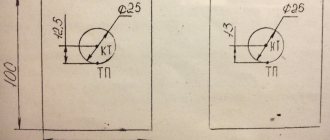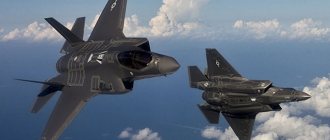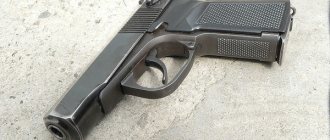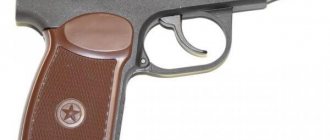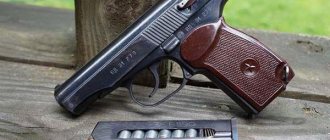m.fotostrana.ru
Weapons of several generations - the legendary Makarov pistol - fail. The Russian Ministry of Internal Affairs adopted the Lebedev compact pistol (PLC). Next, we’ll figure out how the new nine-millimeter is superior to its brother – the mass-produced and most famous model of small arms on the planet.
"Makarov" - passed the post
wiki4.ru
The issue of replacing the Makarov pistol (PM), considered the main army pistol since Soviet times, has been on the agenda for more than 20 years. Despite its time-tested characteristics, it needs replacement: the PM has been in Russian service for more than 70 years. To this day it remains the main personal weapon of officers. There are about 100 thousand “Makarychs” in Russian law enforcement agencies.
The Kalashnikov Concern (part of Rostec) has been developing a replacement for such a popular weapon for a long time. And in 2015, a prototype of the new pistol was presented. Powerful, accurate, reliable, convenient, universal in use - these are the characteristics of the new nine-millimeter Lebedev pistol. The American magazine The National Interest praised the new product and called it a real “quantum leap.” The publication notes that the PLC is significantly superior to existing analogues and combines the best qualities of Russian and Western pistols.
Can't change it
Meanwhile, the question of whether there is a need for a replacement for the Makarov as a mass-produced pistol for law enforcement agencies is not so simple. Yes, the PM is by no means a new product, but among the samples of small arms from different countries there are long-livers and more respectable ages. Even the great and mighty US Army does not hesitate to use a hundred-year-old veteran - the Browning M2 heavy machine gun. The MG 3, also a slightly modified MG.42 from World War II, often serves side by side with it. The Canadian military carries in holsters the High-Power pistol created in 1935 by the same Browning. Many smaller countries are following suit.
Age is not such a convincing argument.
There are, of course, other complaints - small magazine capacity, excessive weight by modern standards, low-power cartridge...
The Canadian military fires high-power pistols
On the other hand, the practice of past wars shows that in battle the bulk of the bloody harvest will be collected by bombs and shells, and from small arms most of the losses will come from machine guns. The value of short-barreled weapons on the scale of a major war is somewhere around the plinth.
The situation is a little more serious with law enforcement agencies - after all, they are not given machine guns every day. But even here the question arises, what kind of problems might the average police officer face if he doesn’t have enough eight 9x18 rounds? To detain the “average” single criminal, as the history of the Soviet police shows, PMA is quite sufficient. And if you take on a gang of terrorists in army-grade bulletproof vests and with machine guns, you’ll hardly be able to fight back with just two pistols.
Of course, there are categories of military personnel for whom a pistol is a truly in-demand working tool. But, firstly, they, as a rule, need to be replaced not by the PM, but by the APS (Stechkin automatic pistol). And secondly, there are not so many of them - is it worth launching mass production for this, or is it easier for people to buy the same Glocks, as they often ask themselves?
"Lebedev" - accepted the post
The new nine-millimeter is lighter than many analogues, smaller in size and more durable. It is perfect for concealed carry. Its dimensions are adjusted so that the holster does not treacherously protrude from the hem of the jacket. The main difference from the Makarov is that the Lebedev fires a 9x19 mm Parabellum cartridge, which provides the bullet with energy up to 620 J. This is twice as powerful as the 9x18 Makarov bullet. Even with these powerful cartridges, the new pistol will last up to 10 thousand shots.
"Lebedev" is available in several configurations: with a standard and long barrel. The weapon can be equipped with a silencer, flashlights, and under-barrel target designators. Different modifications of the pistol have been prepared for different law enforcement agencies. The Ministry of Internal Affairs received a Lebedev with a magazine for 14 Luger cartridges. Bullets are selected as desired: with a steel or lead core, increased penetration, with a tracer bullet, or with a reduced ricochet ability.
A replacement has been selected for the famous Makarov pistol
It is known that the “Boa constrictor” was ordered for the army in two versions - in a combined arms and a special configuration. According to the Commander-in-Chief of the Russian Ground Forces Oleg Salyukov, the second version of the pistol is equipped with a device for low-noise shooting, target designators and a flashlight.
“The Udav pistol complex has improved ergonomic characteristics, increased accuracy and shooting accuracy, and a high barrel life,” the commander-in-chief explained in an interview with Krasnaya Zvezda the reasons for choosing this pistol.
Earlier, the Rostec state corporation, which includes the developer of the Udava, TsNIITOCHMASH, reported that the 9-mm self-loading pistol was developed for a high-power 9x21 mm cartridge. It can penetrate second-class body armor at a distance of several tens of steps. But in principle, all types of ammunition of this caliber are suitable for firing from the Boa Constrictor. This can be a cartridge with ordinary, tracer, armor-piercing bullets. Or ammunition with increased stopping power, increased penetration and subsonic bullet speed, and even a bullet with reduced penetration.
The latter, we note, is used by special forces. For example, when they have to shoot at terrorists who have hijacked a plane.
The Boa Constrictor pistol is not the only new small arms product that the Ground Forces are looking forward to. General Salyukov also spoke about the new 7.62 mm Chukavina sniper rifle - it is also planned to be adopted by the Russian army. According to the commander-in-chief, its state tests were successfully completed this year.
For the Russian army, a new 9-mm self-loading pistol "Boa" was ordered in two versions - in a combined arms and a special configuration
Let us recall that the microwave rifle was developed by the Kalashnikov concern as part of the Reaper development project. It is made according to a layout scheme that is unusual for domestic weapons. Almost the entire load falls on the upper steel part of the rifle. The microwave uses a 7.62x54 cartridge, of which there can be from 10 to 20 in a rifle magazine.
The rifle itself weighs 4.2 kilograms; it can be equipped with a telescopic buttstock with cheekpiece adjustment. And also any attachments: for this, a Picatinny rail was placed along the entire length of the rifle receiver. By the way, the receiver itself, as well as the stock and the barrel are on the same line on this weapon, which reduces its toss at the moment of firing.
General Salyukov also spoke about the combat equipment of the “soldier of the future.” According to him, this year, together with domestic industrial enterprises, extensive work has been carried out to include a new “robotic” subsystem in its composition. This includes mini- and micro-drones, wearable robotic systems, as well as exoskeletons.
It wasn't like that at all
As for the latest high-profile news, after a more in-depth study, everything there also doesn’t look so scary for Makarov. In fact, Albert Bakov, recently appointed general director of the Central Research Institute of Precision Engineering (TSNIITOCHMASH), said in an interview that: “The pistol complex has been created and is undergoing state tests at the training grounds of the Russian Ministry of Defense. Completion of state tests in accordance with the directive of the Russian Ministry of Defense is December 2022, after which a decision will be made on whether to accept it for supply to the Armed Forces of the Russian Federation.”
Russian soldier with a Makarov pistol
As can be seen from this quote, it is too early to rush to hand over the PMs to the weapons shop and demand a cool new barrel in return for the servicemen. A lot has been created over the past 28 years. Some samples even passed these same state tests. Moreover, they are now creating a new pistol chambered for the “unparalleled” 9×21 mm cartridge, which is actually used only in other TsNIITOCHMASH products, and its production volumes with the “Luger” 9×19 mm are, to put it mildly, incomparable. And the advantages compared to the latest Russian versions of the 9x19 with increased armor penetration are not that great. So whether the army, and the police and the Russian National Guard, will want to “climb” to the next new cartridge is a moot point.
In the meantime, “Makarov” still serves among the security forces, especially far from the capitals, and is giving up its positions very slowly and reluctantly.
Development of the design of the Boa constrictor pistol - photo of the proposed version
And finally, let's look at the aesthetic and ergonomic characteristics of the pistol.
Even with the coolest functionality and trouble-free operation, today a modern pistol must have a decent aesthetic appearance combined with ergonomics. In order for it to stand on par with its global competitors, the team of the famous industrial designer Vladimir Pirozhkov was included in the work. Despite its relative compactness, its appearance makes it immediately clear that the pistol contains powerful fire potential.
MP-443: "Rooks" have arrived
Vladimir Yarygin began work on the MP-443 (aka PYa, “Rook”) in 1993: we can say that the designer decided not to reinvent the wheel, but took as a basis the classic Browning automatic - the recoil of the bolt with a short stroke of the barrel, locked with a skew. Note that the vast majority of modern pistols are designed in this way - this scheme is truly successful and time-tested. Locking the barrel allows the use of powerful 7N21 ammunition (9×19 mm), developed by TsNIITochmash - the armor-piercing bullet reaches a speed of 450 m/s.
PYa is a classic combat pistol, designed to be the first fiddle, and not an appendage to the main weapon. The significant dimensions are compensated by a comfortable grip, a long aiming line, an 18-round magazine and modern controls (double-sided safety, magazine release button, and so on). We especially note the well-chosen force on the trigger - Yarygin’s experience in designing sporting weapons had an impact.
With all this, alas, the MP-443 can hardly be called an ideal model. According to reviews from military personnel and practical shooters, it is still “damp” and not reliable enough. Of course, mastering a new model in mass production is not an easy task, and even the standard PM for reliability did not immediately become so. "Rook" seems very promising, but whether it will be able to take off or will ultimately give way to a more successful candidate is not yet clear.
The decision to introduce the Boa constrictor pistol into service
The completion of tests by TsNIITochmash JSC does not mean that the pistol will be successfully put into service instead of the PM. Next comes the difficult stage of reviewing the weapon by an interdepartmental commission for approval of mass production. Upon positive consideration, the weapon is assigned the symbols “01”, which give further green light for the manufacture of the “Boa Constrictor” pistol on a production scale. The final deadline for making a decision is scheduled for the end of March 2022.
Armament at your own expense
At the government level, the introduction of revolvers into the army as personal small arms for officers was first discussed after the end of the Crimean War of 1853-1856. Military actions revealed the lag of the Russian Empire in the field of small arms from the armies of European powers. In particular, smooth-bore single-shot pistols caused great criticism, while the enemy already had revolvers in use. To correct the current situation D.A. Milyutin, who served as Minister of War, ordered the creation of the Weapons Commission of the Artillery Committee of the Main Artillery Directorate to test foreign-made revolvers in order to select the best one. The most impressive technical characteristics were shown by the Lefoshe revolver, produced in France. Representatives of the commission noted its high rate of fire, unpretentiousness and reliability in battle. However, there was an opportunity with the purchase of French revolvers: they turned out to be too expensive for the treasury of the Russian Empire exhausted by the war. Therefore, army officers were asked to purchase revolvers at their own expense, and the state purchased only 7,100 Lefoshe revolvers for the gendarmes. The reform failed.
Why are they creating a new pistol?
The PM was developed in 1948 and entered service three years later. Now it is the most popular pistol in the Russian army; a large number of combat, service and civilian modifications have been developed on its basis. In addition to the PM, the Russian Armed Forces use a Stechkin pistol chambered for the 9×18 cartridge.
In recent years, Russia has repeatedly made attempts to create a new combat pistol that would be widely used in the army, intelligence services and police. Meanwhile, all the new items, in particular, the Yarygin pistol and the Serdyukov pistol, never became widespread.
